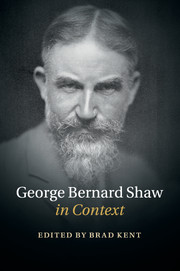Book contents
- Frontmatter
- Dedication
- Contents
- List of illustrations
- Notes on contributors
- Preface
- Acknowledgements
- A Chronology of Shaw's Works
- List of abbreviations
- PART I PEOPLE AND PLACES
- PART II THEATRE
- 7 The Abbey Theatre
- 8 Actors and actresses
- 9 The Court Theatre
- 10 Fabian drama
- 11 Farcical comedy
- 12 History plays
- 13 Melodrama
- 14 The New Drama
- PART III WRITING AND THE ARTS
- PART IV POLITICS
- PART V CULTURE AND SOCIETY
- PART VI RECEPTION AND AFTERLIFE
- Further reading
- Index
- References
7 - The Abbey Theatre
from PART II - THEATRE
Published online by Cambridge University Press: 05 October 2015
- Frontmatter
- Dedication
- Contents
- List of illustrations
- Notes on contributors
- Preface
- Acknowledgements
- A Chronology of Shaw's Works
- List of abbreviations
- PART I PEOPLE AND PLACES
- PART II THEATRE
- 7 The Abbey Theatre
- 8 Actors and actresses
- 9 The Court Theatre
- 10 Fabian drama
- 11 Farcical comedy
- 12 History plays
- 13 Melodrama
- 14 The New Drama
- PART III WRITING AND THE ARTS
- PART IV POLITICS
- PART V CULTURE AND SOCIETY
- PART VI RECEPTION AND AFTERLIFE
- Further reading
- Index
- References
Summary
Bernard Shaw is usually omitted from critical studies and histories of the Irish Dramatic Revival. The reasons are not far to seek. By the time Ireland's National Theatre was founded at the Abbey in 1904, Shaw had been resident in England for almost thirty years and had written a series of plays set there. But while he continued to reside in England and have his plays premiered in London, this did not preclude an active interest and involvement on Shaw's part in the Irish Dramatic Revival, to whose repertoire his John Bull's Other Island is a major contribution. There were other significant involvements in the Abbey Theatre by Shaw, including its staging in 1909 of The Shewing-up of Blanco Posnet, a play that the Lord Chamberlain had banned from performance in England. Yeats and Lady Gregory argued passionately not only against those who found Blanco Posnet offensive but equally against those who contended ‘that it is not a fitting thing for us to set upon our stage the work of an Irishman, who is also the most famous of living dramatists’. In 1915, Shaw wrote a one-act play for the Abbey Theatre set (like most of John Bull) in Ireland, O'Flaherty, V.C. The military authorities felt its subject matter of recruiting far too volatile to be staged in Ireland at the height of World War I. On this occasion, the Abbey backed down and the play was not staged there. But the debate over Shaw's play in many ways anticipates the later argument concerning Sean O'Casey's World War I play, The Silver Tassie (1929), which the Abbey rejected and which Shaw vigorously defended. In this and other ways, Shaw continued to wield a strong influence on the Abbey Theatre from across the Irish Sea.
When first confronted in 1894 with Arms and the Man on stage, Yeats reacted with what he described as ‘admiration and hatred’. His conflicted feelings about Shaw's drama emerged most fully in 1904 in response to John Bull, which he had commissioned for the opening of Ireland's National Theatre at the Abbey. In his letter to Shaw, Yeats naturally accentuated the positive: ‘You have said things in this play which are entirely true about Ireland, things which nobody has ever said before, and these are the very things which are most part of the action’.
- Type
- Chapter
- Information
- George Bernard Shaw in Context , pp. 53 - 60Publisher: Cambridge University PressPrint publication year: 2015

